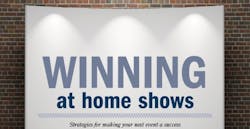So it’s home show season again and, if you’re like many companies, you’re wondering if this year will be better than past years for gathering leads.
How will you get people to stop at your booth, and will your people gather a sufficient number of leads for a profitable outcome?
For better home show results, read on to discover ways to make your booth more successful.
Every Conversation an Opportunity
Every time you have a conversation with people attending a show, you have an opportunity to develop an appointment. So think of ways to be different and stand out from the crowd. Your goal is to start a conversation and be in the game. One very successful company has set up a “blow-up” jumping jungle gym for kids. The kids come and play for a while; meanwhile, the parents are perfectly positioned for a brief and pleasant conversation about their home. This is called an “interruption, attraction device.”
First, make sure you are not the exhibitor whose staff is sitting in chairs and appearing bored, as if they do not want to be there. Ensure you and your personnel are never eating or drinking. Make sure no one is reading magazines or newspapers or staring off into space. Ensure talking or texting on cell phones does not take place, and attendees are not ignored when they indicate interest in or near your booth because your personnel is busy doing some or all of the above.
7 Improvement Strategies for Successful Shows and Events
1. Don’t use sales reps: They will contaminate the lead gathering process. Use promoters instead. The goal of a salesperson working the booth is not in sync with the company goals of creating a high number of leads to work in the present as well as long into the future.
2. Don’t allow promoters to work alone: Always have at least two people working a shift, as well as a supervisor working with your team throughout the show. They need to be managed for a successful outcome.
3. Don’t undersize and overfill your booth: Maintain an uncluttered, open, and attractive look. Keep your signage sharp and easy to observe from a distance.
4. Win the battle of the first impression: Make sure nothing looks weathered or worn. People do make decisions that are both positive and negative based on their first impressions of your booth and your people.
5. Have the right tools: Pictures, samples, uniform dress, lead cards, and appointment reminders.
6. Control the conversation: Otherwise promoters will say too much or too little, and usually many of the wrong things.
7. Ensure you calculate fully loaded costs: They are more than you might think.
Controlling the conversation with scripting is a difference maker. Scripting for the show staff is often misunderstood and mismanaged, and greatly contributes to poor results and outcomes. When your personnel does not have scripted things to say (openers, for example), they are apt to ask questions such, “How are you today?” or “Great day isn’t it?” and “Are you enjoying the show today?”
These really are lost questions, as they take you nowhere in starting a genuine conversation of potential value to you or the person you are attempting to reach. The properly scripted promoter will uncover both wants and needs, then ask how long the homeowner has been considering such an improvement and what has kept them from doing something.
Most people don’t want to feel as if they have been taken hostage or convinced against their will, so show pictures and samples that appeal to their senses and emotions.
Golden Rule: Be scripted but brief
Don’t spout facts and data for 10-plus minutes; no matter how good you are, no one will remember what you said by the time they get home. Don’t give them clichés (e.g., your company is the best) and don’t try to sell the job in the booth. Tell them your company is great at making sure the client gets their desired outcome and explain that it all starts by examining their home and the scope of the project to determine if what they want and need to have done can be done and made affordable for them.
Suggest you might be able to help them whether now or in the future (this type of statement reduces stress), and it would be worth their time to explore some ideas and solutions together for their current or future consideration (also a statement that reduces stress). Make it clear it’s appropriate to discuss their interests with you, even if they aren’t ready to buy right now (consultative selling). Then, right there in your booth, suggest they set an appointment to meet at their home and see where it takes you. The more you ask, the more you will get.
Opener examples:
- “Sir/Ma’am, if you were to improve your kitchen, what would be the first thing you would do?”
- “Sir/Ma’am, what’s the one thing you dislike about your bathroom the most?”
- “If you could change one thing about your windows, siding, or deck, what would it be?”
- “How long have you been unhappy with…?”
- “What has kept you from making the improvement?”
- “Did you know that our company—XYZ Home improvement—now has more ways to update your [insert project here] than ever before. Let’s have a trained adviser take a look at what you have there and understand what you need and want to have done and, of course, make sure that it can be done the way you want it.”
- “There’s no cost for the inspection and design ideas.”
- “We are now scheduling for [insert project here]. Which would be best for you for the visit?”
Consult our company blog for more information on shows and events (www.daveyoho.com/wordpress). If you’re disappointed in your results from previous shows, try a new plan and include what you’ve just read. Make shows and events a part of your future marketing plans. PR
--
Joe Talmon is an account executive with Dave Yoho Associates. He has 26 years experience with in-home sales and sales management and has developed programs for large-, mid-, and small-sized home improvement companies selling directly to homeowners. Contact Joe Talmon at [email protected].
About the Author

Dave Yoho
Dave Yoho is the president of Dave Yoho Associates, Fairfax, Va., founded his consulting company in 1962. It is the oldest, largest, and most successful consulting company in the industry. They also produce the best selling recorded (CD) series “The Science of Successful In-Home Selling” and the web-based video training series “Super Sales Training.” Visit www.daveyoho.com or call 703.591.2490. For more information on presentation development and additional information on sales presentations, consult the blog www.daveyoho.com/wordpress.
